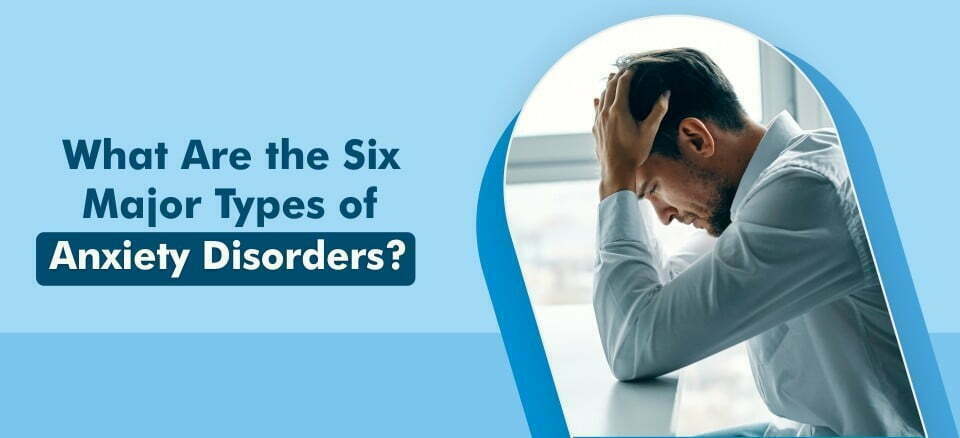


[vc_row][vc_column][vc_column_text]
Anxiety affects different people in distinctive ways. Generally, it is a feeling of tension or nervousness. But what is anxiety? What are anxiety disorders? What exactly do anxiety disorders look like? How can you tell if you or someone around you is suffering? And what distinguishes them from other types of mental illnesses?
In this article, we’ll answer all these burning questions.
Plus, we’ll go over the most common types of anxiety disorders and how they manifest themselves in different ways.
Anxiety is a part of life that we all experience from time to time. It’s a response to a perceived threat, and it can be characterised by feelings of worry, fear and uneasiness. When you are anxious about something, your body releases adrenaline which causes your heart rate to increase and blood pressure to rise.
However, when you have an anxiety disorder, these symptoms become extreme and interfere with day-to-day life. In severe cases, they can make it tough for someone to leave their home or hold down a job.
This is because their constant worrying drain them over things that may never happen or could easily be dealt with if they were only given some perspective on things.
Anxiety disorders are some of the most common mental illnesses. They’re a group of mental illnesses that affect the way people feel, think and behave. For a person with an anxiety disorder, it can be hard to do normal daily activities or work or lead a normal social life. These disorders can range from relatively mild to severe.
Anxiety disorders are more than just feeling anxious about something for no apparent reason; they cause distress and impairment in daily life. You may have trouble controlling your thoughts or feelings so that they don’t interfere with your ability to function normally.
Generalised Anxiety Disorder (GAD)
Generalised anxiety disorder (GAD) is characterised by free-floating anxiety that is not triggered by a specific event or situation. It’s like having butterflies in your stomach all day long, even when there’s nothing to be anxious about.
Symptoms of GAD include:
Panic disorder is a mental illness that causes sudden and repeated panic attacks. Panic attacks are intense feelings of fear, terror, or impending doom that strike without warning and can last from just a few minutes to several hours.
You may feel like you’re having a heart attack or going crazy, and you may sweat, tremble, faint, feel nauseous or lightheaded, have chest pains and trouble breathing.
Your first panic attack usually comes on suddenly in response to an identifiable trigger, such as crossing a bridge or speaking in public—the exact cause varies by person.
After the initial occurrence of a panic attack, it becomes possible for other situations (triggers) to bring about an episode in someone who has had these symptoms previously.

In obsessive-compulsive disorder (OCD), people experience unwanted thoughts (obsessions) and repetitive behaviours (compulsions). The obsessions or compulsions cause significant distress, interfere with daily functioning, or are time-consuming.
While everyone has occasional intrusive thoughts, people with OCD can’t control their reactions to these thoughts. They may spend hours each day carrying out rituals like hand washing or repeatedly checking to make sure the stove is turned off.
Social anxiety disorder (SAD) is more than just shyness. It’s an intense fear of being judged or embarrassed in social situations, which can lead to a variety of symptoms, including:
While some people may have social anxiety once in a while and then get over their fears and move on with their lives, those who have social anxiety disorder will experience these feelings on a regular basis and across many different settings.
Post-traumatic stress disorder (PTSD) is a mental health condition that may occur after a person experiences or sees something traumatic, such as sexual assault, physical violence, or combat.
The symptoms of PTSD may include:
Phobic anxiety disorders are characterised by intense and persistent fear of a specific object or situation. The person has an irrational and unrealistic fear that results in a compelling desire to avoid the feared object or situation.
People with phobia tend to know that their fear is irrational, but they feel powerless to overcome it. In some cases, they may be aware that they’re not in any danger from the object of their fear, but their body reacts as if there were real danger. For example, someone with acrophobia (a fear of heights) may feel dizzy and nauseated just looking out the window of an aeroplane at 30,000 feet.
Learning more about the types of anxiety disorders can help people understand their symptoms and seek help. Remember that everyone experiences anxiety differently and it can be difficult to diagnose yourself with an anxiety disorder, so be sure to talk to a doctor if you think this could apply.
While there are various types of treatments available today, there is no one-size-fits-all treatment plan for everyone—people need to find what works best for them and their symptoms.
Amandeep Hospital offers tailor-made treatment and diagnosis for our patients. This is made feasible by our team of expert Internists, Psychologists, Medical Assistants and Nurses. We offer comprehensive care for tackling chronic and acute disorders through the latest technologies and infrastructure.
The Internal Medicine Department in Hospital offers treatment for various anxiety disorders caused by different factors. So, if you are struggling with anxiety, there is no reason to wait. Come to Amandeep Hospital and get relieved. Book an appointment with us today.
[/vc_column_text][/vc_column][/vc_row]
September 30, 2024
Recognize the Signs: Understanding Appendicitis Pain Symptoms
September 24, 2024
Unveiling the Truth: I-Pill Side Effects Every Woman Should Know
We use cookies to enhance your experience. By clicking "Accept", you agree to our use of cookies.